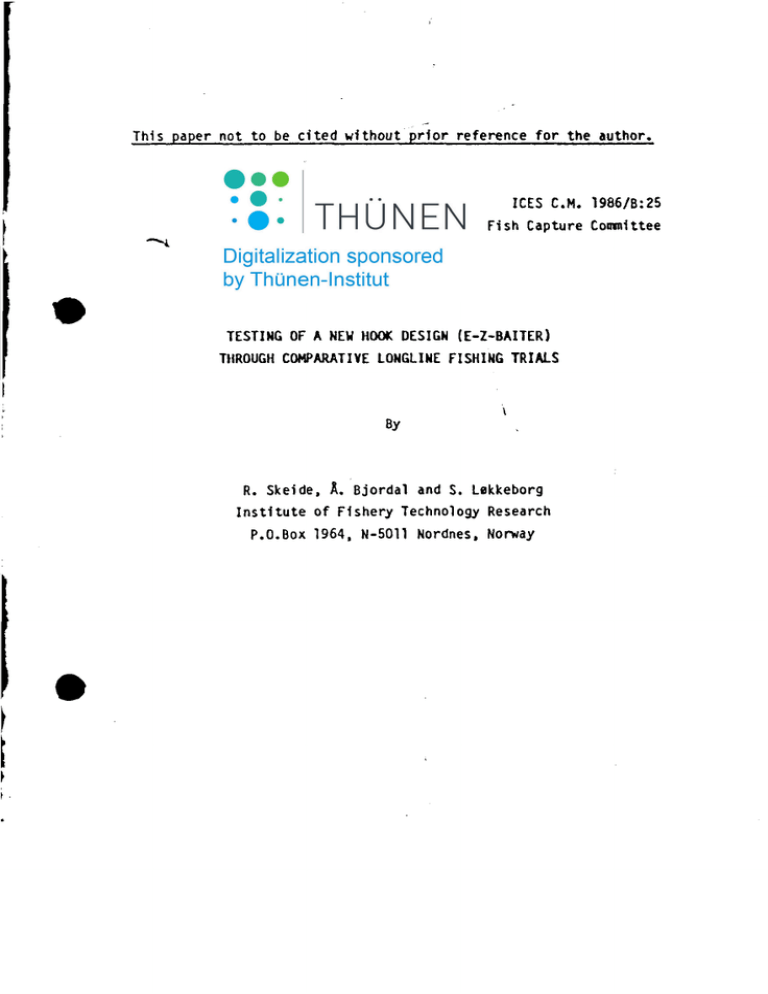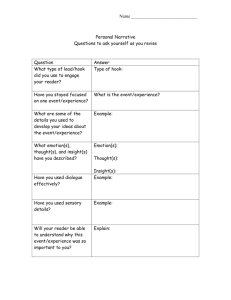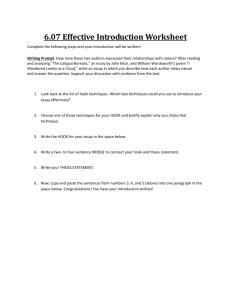reterence tor ICES C.M. 1986/B:25 F;sh Capture Committee
advertisement

This paper not to be c;ted without prior reterence tor the author.
ICES C.M. 1986/B:25
F;sh Capture Committee
TESTING OF A NEW HOOK DESIGN (E-Z-BAITER)
T1IROUGH COMPARATIVE LONGLINE FISHING TRIAlS
By
R. Skeide, A. Bjorda1 and S. Lekkeborg
Institute of Fishery Techno1ogy Research
P.O.Box 1964, N-5011 Nordnes, Norway
I·
H 0 0 K C 0 MPAR ISO N
a.
b.
d.
c~
r
'"--
•
j
~\D
&:
§~
~:-,..,
N
-c
......
a. Standard hook. E-Z-Baiter (straight). Qual. 39975, No. 12/0
b. Test hook no. 1.
E-Z-Baiter (kirbed), Qual. 39975. No. 12/0
c. Test hook no. 2.
Kirby (kirbed). Qual. 2330, No. 4
d. Test hook no. 3.
Norway (straight), Qual. 7255, No. 8
1
.
- 2 -
SUMHARY
A new hook design~ the E-Z-Baiter Circle hook was tested against two
different traditional hook types in the longline fishery for cod (~
morhual and haddock (HelanoQrammus aeglefinus). The new hook design
gave significantly improved catch rates for both species. The cateh
increase in the two comparisons were 18 and 24 ~ for cod and 46 and 54
~ for haddocl:..
A comparative trial between a straight and a kirbed version of the
hook design gave no dlfferance in catch rates.
new
The new hook design showed specifically good catchlng performance for
fish that were hooked by the jaw (compared to those that swallowed the
hook). This may indlcate that the E-Z-Saiter Circle hook also is
effective for other species that mainly are hooked in the jaw, like
ling and halibut.
1.
INTRODUCTION
The E-Z-Baiter Circle Hook is a new hook design developed for longline
ffshing by O. Mustad & S0n AIS. This hook type is an intermedfate
design between a circle hook and a standard (j)-hook.
~
During the last few years the Cfrcle hook has proven to be superior to
standard hook types in the US- and Canadlan longline fishery (Peeling.
1985). Ilowever, the Circle hook could not be used in mechanized
longline systems. The development of the,new hook design therefore had
a dual purpose: increased hooking 'efficiency and possibi1ity for
mechanlzed handling and baiting.
The main objective with these fishing trials was to test the hooking
efficiency of the E~Z·Baiter Circle hook compared with standard
longline hooks.
- 3 -
2. MATERIALS ANO HETHOOS
2.1 Ffshing operation
The fishing trfals were eondueted from January 30 to february 6, 1986
on a 33 m longlfne vessel (H!S -Knut Senior-I. The boat was fishing
wfth bottom set longlfne for eod and haddoek at the North Cape Bank off
the eoast cf Finnmark.
The lfne unft (skate) were rigged··wfth 150 hooks with 1.8 m hook
spacing (270 m total length). IThe .mainlfne were 7 1I11l; (diam.),
tartreated spun polyester, with terylene gangions (2 lI11l diam,l; length
0.5 m). The total amout of gear was 4 fleets of 20 skates each. Each
day 6 fleets of gear were hauled (18 000 hooks).
_.
The lines were handbafted with squfd.
2.2 Experfmental desfgn
A total of 18 skates were used for the experiment (all new gear),
giving 6 skates for each experiment. Each skate was divfded in two
parts, wfth 75 hooks of one type on the first half (standard) and 75
hooks of another type on the second half (test). Such each skate
eomprised one pair of comparison fn the experiment. The combinations of
hook-types fn the different experiments are given fn Table 1•.
Data were recorded during haulfng of the gear on a portable
dataterminal, Hicronfc 445 (Floen, 1985). For every hook the fol10wfng
fnformatfon was recorded: 1I00k status (hook missfng, bait loss, bait
remnant, fntact baft), specfes (eod, haddoek, byeateh, trashffsh),
hooking position for cod and haddoek (jaw, throat) and gear-tangles.
Further, cod and haddock were length measured (total length). After
haulfng ofione fleet of gear, the data were transferred to a personal
computer for storage and prelimfnary processfng. A total of 36 skates
(5400 hooks) were fncluded fn each of the three experfments. During
~
- 4 -
most of the trial period. the weather conditions were fairly bad with a
gale and rough seas.
3.
RESULTS
'
3.1 E-Z-Baiter (straight) versus E-Z-Baiter
(~irbed)
The resu1ts are given 1n lable 2a-c. lhis exper1ment showed that there
was no dlfferenee between the straight and the ~irbed vers10n of the
E-Z-Baiter hoo~. neither for cateh rates. 1ength distr1bution (see Fig.
1 and 2). hoo~ status nor hooking position.
3.2 E-Z-Baiter (straiohtl versus Mustad Kirby
lhe results (lable 3a-e) clear1y show that the E-Z-Baiter hoo~ Is
signlficant1y more effective than the traditional longline hoo~. The
average over all cateh inerease was 27.2: (eod 24.1~ and haddoek
54.6:). For haddoek there was no significant dlfferenee in mean 1ength
between the two types of hooks. whi1e for cod the E-Z-Baiter caught
fish of s1ightly smaller size. This is probably due to the slightly
smaller s1ze of the E-Z-hook resulting in some higher loss during
hauling in bad weather. The length distributions are shown in Fig. 3
and 4.
Further the [-Z-hook gave less bait loss and for cod a hfgher
proportion of fish that were hooked in the jaw. compared with the
tradftfonal hook design.
3.3 E-Z-Baiter (straight) versus Mustad Norway
The results are gfven in fable 4a-c. Also in thfs exper1me~t the
E-Z-Bafter hoo~ gave significantly better catch rates compared with the
tradft10nal hook type. but wfth no significant difference fn ffsh sfze.
rurther the E-Z-Baiter hoo~ had slightly less bait loss and again a
- 5
~
hfgher proportfon of ffsh that were hooked in the jaw.
I
4.
DISCUSSION
The results clearly demontrates the superiority of the E-Z-Baiter hook
compared with the two traditional longline hook desfgns.
)
The effectfveness of a longline hook 1s mainly determfnated by 1ts
shape and dimension. In some f1sheries.· kirbed hooks have shown to be
more effectfve than straight hooks. However. thfs effect was not
obtafned in these trfals.
~
Of the two tradftional hook types. one were bfgger (Kfrby) and one
smaller CNorway) than the E~Z-Bafter hook. The results clearly indfcate
the effect of dfmensfon. as the smallest hook (Norway) gave relat1vely
hfgher catch rates than the biggest hook (Kirby) 1n the separate
comparfsons with the E-Z-hook. . •
t
However. the E~Z-hook proved to be superior to both the tradftional
hook types. and this is clearly a result of the specific shape of the
new hook design.
The fact that the E-Z-hook gave less baft loss also fndicate the higher
efffcfency of this hook. The fish might remove the bait without
getting hooked. but the bait 10ss from this reason will be less for a
hook with a higher hooking probability.
The E-Z-Ba1ter hook compared wfth the traditional hooks was also shown
to have good properties for catching the fish in the jaw. Thls 1ndlcate
that the E-Z-hook mfght be effectfve also for other specfes with a
hooking behaviour that leads to a high proportion of jaw-hooking Ce.g.
ling and halibut).
....
r
-.
5.
REFERENCES.
Floen, S. 1985. Experimental design for data collection and analysis
in comparative longline fishing trials. Meeting in Bergen, Hay
28 - 31, 1985 of the ICES Ad Hoc WG on Art1f1c1al Ba1t and Bait
Attraction.
Peeling, C.' 1985. Circle hook compar1~on study. Project sUll11lary No.
·2. Fish.Dev.Branch, Fisheries and Oceans, Halifax, March 1985•
•
Table 1. Standard (5) and test (T) hook types used in the three
experiments. The dimensions given are average values from 10 hooks of
each type.
Hook type
Exp.no.
•
2
S
E-Z-Baiter,Qual.39975,No.12/0.straight
T
E-Z-Baiter,Qual.39975,No.12/0,kirbed
S
E-Z-Baiter,Qual.39975,No.12/0,straight
Hook dimens ions (1l11l)
Barb
Shank
Point
length width diam.
12.0
3.9
2.3
---~~-~-~-~~~--~---~~~--~~-~~~~----~~~-~------~~--------------~~~---~-~.
T
Mustad Kirby,Qual.2330,No.4, kirbed
14.3
4.56
2.6
-------~~~---~~-~~~--~~~-~----~------~--~~~~~~-------------~~~---------~----~--
S
E-Z-Baiter,Qual.39975,No.12/0,straight
T
Mustad NorwaY,Qual.7255,No.8,stra1ght
,
.1
10.85
3.45
2.0
- 7-
Table 2a.
Experiment 1: E-Z-Baiter (straight) versus E-Z-Baiter
Catch and length data.
Species
type
No. of fish
Catch rate
**Catch
increase 't
***Si gni fi cance
Hoo~
Mean length
****+/-95:t
probabi1i ty
No. of
measurements
Significance
Other
Haddoc~
tod
*S
375
14.0
*T
324
14.3
T
56
2.5
S
73
2.7
Total catch
T
156
6.9
S
196
7.3
(~irbed).
T
387
17.1
S
453
17.0
2.1
-9.3
-5.9
1.0
0.812
0.641
0.604
0.917
60.32
0.92
61.16 49.20
1.06 2.18
48.52
2.48
74
51
374
321
0.235
0.688
* S (Standard hooK): E-Z-Baiter (straight). * T (Test hoo~):
E-Z-ßaiter (Kirbed)
** Catch increase relative to the standard hook
.
*** Significance: If < 0.05 the result is significant
**** Confidence limit: -Possible range from mean length with 95't probability
Table 2b.
Hoo~
Experiment 1:
1I00K status for hooKs wi thout catch (':;)
status
Standard hoo~
Test hool:
Table 2c.
BaH 10ss
Balt remnant
Intact bait
45.2
45.2
4.2
5.1
50.8
49.7
Experiment 1: Hool:lng position (':;)
lIaddock
Cod
Hool:ing position
Standard hOOK
Test hool:
----
_-_
_---_
Jaw
Throat
Other
Jaw
78.1
79.0
16.8
16.0
5.1
4.9
100
100
Throat
o
o
Other
o
o
_--------------_ .. -----------~-~~---------~~---------
I
- 8 -
I
Table 3a. Experiment 2: E-Z-Baiter (straight) versus Hustad Kirby.
Catch and length data.
----~----~-------~-~------------------------~------~--.-~------------~--~-----
~
ri
Haddock
Cod
Speeies
Other
Tota1 ca tch
--------~---r-~--·--~~-~--~---~~------~-------~-----~~--~~--------------·----T
Hook type
No. of fish
Catch rate
**Catch
inerease :.
***Significance
eMean length
****+/-951probability
No. of
measurements
Significance
*S
*T
446
275
16.8
12.8
-24.1
S
T
S
T
.84
3.2
31
1.4
158
6.0
100
4.6
0.000
60.20
0.90
266
T
-54.6
-22.1
0.000
0.053
0.000
62.12 49.72
1.29 1.58
447
S
531
314
20.1
14.6
-27.2 .
49.54
3.67
80
31
0.91
0.0147
--~------------------------------------------------~----~---------------------
* S (Standard hook): E-Z-Baiter (straight), * T (Test hook):
.
Mustad Kirby (kirbed)
** Catch inerease relative to the standard hook
*** Significance: If < 0.05 the result is signifieant
**** Confidence,limit: -Possible range from mean length with 95:. probability
Table 3b.
Experiment 2:
Hook status tor hooks without eateh (:.)
-----------~~-~-~~~-----------~----~--~----7------~~----~------~--~-~-----~~-~
8ait 10ss
Hook status
Bait remnant
Intaet batt
-----~~----~-----~-~--~~------------~-~-----~---~--~---------~---~--~~--~-----
Standard hook
Test hook
49.1
60.7 .
,
3.2
3.1
47.8
36.2
~ --~~------------------------------~--------------------------------------~--~-
Table 3e. Experiment 2:
Hooking position (:.)
----------~----------~----------------------~-------------------------~-------
Cod
Hooking position
Standard hook
Te~t hool:.
Haddoek
Jaw
Throat
Other
Jaw
Throat
Other
79.1
17.0
63.6
29.1
3.8
7.3
98.8
93.5
o
o
1.2
6.
- 9 -
Table 4a.
Experiment 3: E-Z-Baiter (straight) versus Mustad Norway.
Catch and lenght data.
Hool: type
No. of ffsh
Catch rate
**Catch
increase \
***Si gni fi eanee
Mean length
****t /-95:probability
No. of
measurements
Sfgniffcance
*
**
***
****
*S
487
17 .8
*T
338
14.6
-18.0
T
26
1.1
S
57
2.1
0.005
60.71
0.88
Other
Haddoek.
Cod
Species
484
334
T
99
4.3
S
109
4.0
-46.1
7.3
0.006
0.662
61.67 48.07
1.09 1.97
Total catch
S
547
19.9
T
371
16.0
-19.9
0.001
•
48.85
3.00
55
28
0.65
0.17
S (Standard hook): E-Z-Baiter, * T (Test hook): Mustad Norway (straight)
Catch inerease relative to the standard hook
Signfficance: If
0.05 the result is significant
Confidence limit: Possib1e range from mean length with 95~ probability
Table 4b.
Hook status for hook without catch (\)
Ilook status
Bait 10ss
Bait remnant
Intaet bait
49.4
3.7
3.7
43.6
Standard hook
Test hook
lable 4c.
52.7
Ilooking position
46.9
(~)
Haddock
Cod
Hooking position
Standard hook
lest hook
Jaw
Throat
Other
Jaw
Throat
Other
78.2
62.4
17.7
31.4
4.1
6.2
98.2
100
o
o
1.8
o
•
140
..........
~k1;g;~jer
------ E-Z-Baiter
120
100
80
"l:l
0
u
....
0
,;
;z
60
f e
40
20
0
11 30
Figure 1.
30
a
60
70
Length
(ern)
50
40
80
90
100
Length distribution of eod in experiment 1
r---------------~---------,
.......... E-Z-Baiter
(kirbed)
------ E·Z-Baiter
20
u
0
"'0
"'0
....'"
..c:
0
ö
z
10
o
110
il
20
30
40
50
60
Length (ern)
ll'nllth distrihlJtio" nf
h~(loI(,d'
i'" "~l'''l'h,... "t
70
80
Ki rby (ki rbed)
E-Z-Baiter
....
70
Length
Figure 3.
80
90
100
110
(ern)
Length distribution of eod in experiment 2
40
Kirby
E-Z-Baiter
30
.><
u
0
""
"'
oe
20
"0
•
ö
:z:
~
10
o
Figure 4.
"
11
20
30
40
50
60
Length (ern)
length distribution of haddoek in experiment 2
~-----._-----
--
--~
-
-
140
......... - Norway No. 8
- - [-Z-BaHer
120
100
"'0
80
0
u
.....0
Ö
z
60
e
40
20
0
11 30 .
40
50
70
60
Length
90
80
100
110
(ern)
Figure 5. Length distribution of eod in experiment 3
30
...-----------------r----------,
......... - Norway No. 8
- - [-Z-Baiter
~
20
"'0
"'0
'"
.c
.....0
ö
z:
10
o
il
20
30
40
50
Length
Fi'1""" (.
l.P/,wh
distribution n '.,
(ern)
'ri"f'~
.
60
70
80





